Equine Rehab Therapies: How Do They Work?
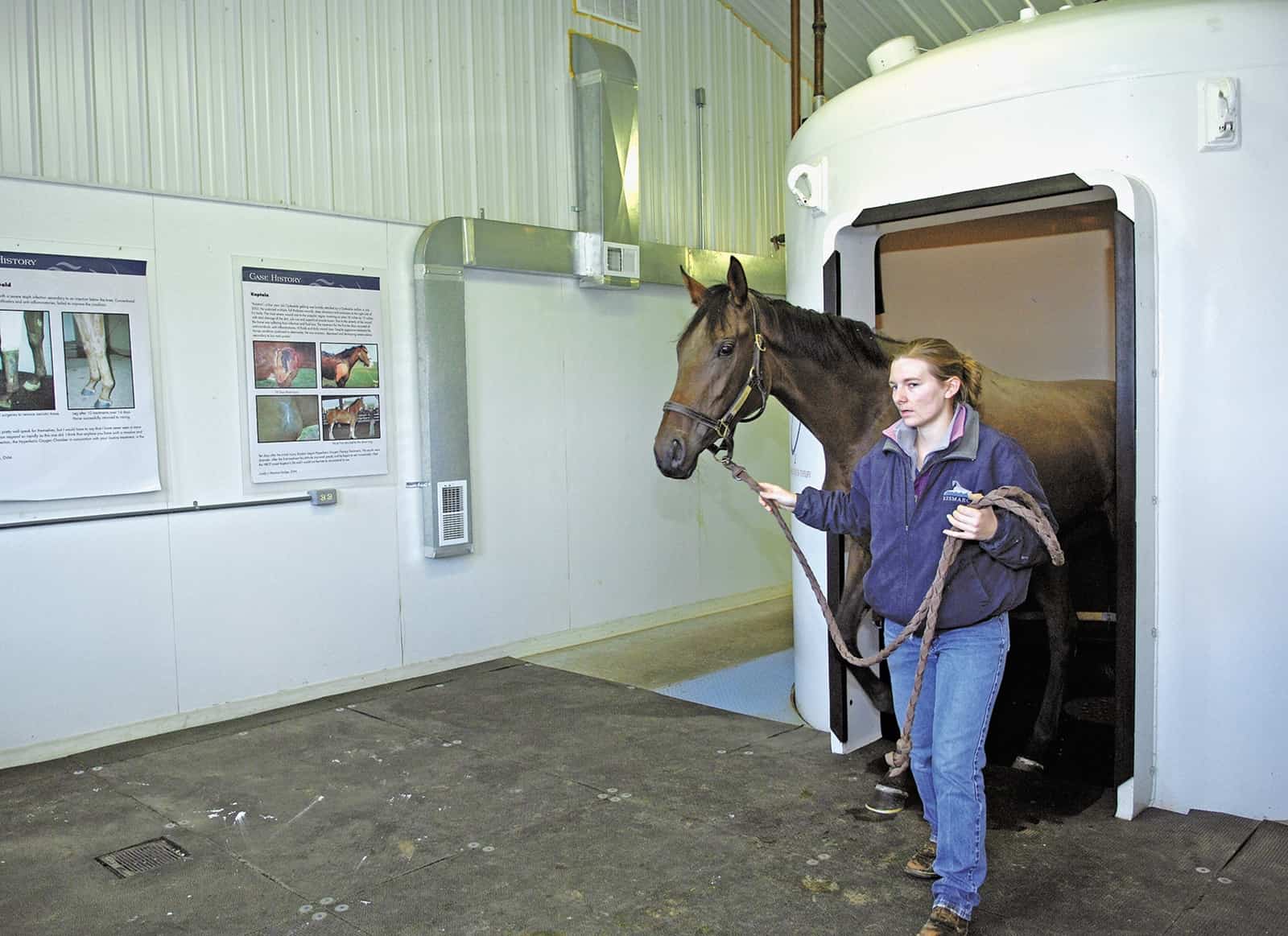
A look at five noninvasive high-tech therapies—from lasers to ceramic-thread blankets—and how they might help horses heal
The horse owner could see a notable difference in the way her Warmblood gelding moved as her trainer led him out of his stall. It had been a long road to recovery from a suspensory ligament injury, but the horse appeared sound and his muscle tone had improved greatly. He marched down the barn aisle, stepped up onto the vibration platform as he’d done daily during the past several months of stall rest, and awaited his treatment.
Across the aisle, an old gray mare snoozed under her pulsed electromagnetic field therapy blanket. And a few stalls down, an equine physiotherapist performed low-level light therapy on the barn’s star dressage horse to help heal a tendon injury.
While similar scenes once were limited to equine sports medicine clinics or rehab centers, nowadays you can witness them at sport horse barns as owners seek noninvasive therapies to help their charges recover from injury or maintain fitness.
Despite their popularity, however, research supporting some of these techniques in horses remains limited. Often, when equine studies are not available, veterinarians extrapolate from those conducted in other species.
Because understanding the science behind these modalities can help owners make educated decisions when a veterinarian recommends them, we’ve taken a look at what we do know about hyperbaric oxygen, laser, electromagnetic, vibration, and heat radiation therapies.
Hyperbaric Oxygen Therapy
Visit a large equine veterinary clinic, and you might notice a domed chamber called a hyperbaric oxygen therapy (HBOT) unit. This therapy isn’t available everywhere, due to the unit’s size, cost, and unique requirements for use, but there’s one available at Hagyard Equine Medical Institute (HEMI), in Lexington, Kentucky.
Liz Barrett, DVM, MS, Dipl. ACVS, an associate veterinarian at HEMI, adds HBOT to treatment regimens for a variety of equine cases to reduce healing time.
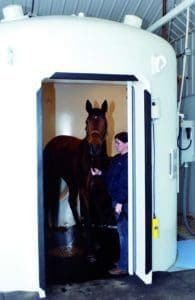
“We have used it as an adjunctive therapy for a lot of conditions at HEMI, including chronic infections and wounds, skin grafts, clostridial infections, and to help speed (healing of) soft tissue injuries, laminitis, various colic conditions, and dummy foals,” she says, adding that the number of treatments, duration, and pressure depend on the condition.
The air we breathe is typically comprised of 21% oxygen, 78% nitrogen, and about 1% carbon dioxide, Barrett explains. During a treatment in an airtight HBOT chamber, the horse is exposed to increased atmospheric pressure of two to three ATA (atmosphere absolute; 1 ATA is the pressure at sea level). Pure oxygen slowly replaces the air in the chamber.
“In very simple terms, HBOT works by maximizing the amount of oxygen a horse is breathing in, which should then lead to the maximum amount of oxygen being offloaded (transferred) from the lungs into the bloodstream and perfusing the tissues with higher concentrations of oxygen,” says Barrett. “These increased levels of oxygen help combat oxidative injury, inflammation, and edema (fluid swelling) in the body. (They) can also help certain antibiotics work more effectively.”
Oxidative stress occurs when there is a disturbance in the balance of free radicals (highly unstable molecules) and the body’s natural antioxidant defenses. Scientists have linked oxidative stress to cell damage and diseases ranging from heart disease to cancer. During an HBOT treatment, oxygen enters the blood plasma or binds to hemoglobin in red blood cells and scavenges those damaging free radicals. Through this process HBOT causes blood vessels to constrict, reduces swelling, increases cell division, and stimulates healing.
Dennis Geiser, DVM, Dipl. ABVP, assistant dean for organizational development and external affairs and assistant professor at the University of Tennessee’s Department of Large Animal Clinical Sciences, authored a 2016 paper about HBOT in Veterinary Clinics of North America: Equine Practice. In it he wrote, “The indications list for the use of HBOT in the horse has been developed through extrapolation from a review of human indications and from anecdotal clinical experiences.”
In other words, equine researchers haven’t conducted many studies on HBOT, which is likely due to limited budgets and access to HBOT chambers. Most of what the veterinary community knows about HBOT has come from trying it.
However, wrote Geiser, “hyperbaric therapy is a safe treatment option with very few side effects when administered properly.”
Low-Level Laser Therapy
Veterinarians might prescribe low-level laser therapy (LLLT) in horses to try to improve healing, increase circulation, and reduce inflammation. They use these low-powered lasers (also known as cold lasers or therapeutic lasers) at different wavelengths and body locations depending on the desired effect.
Researchers have studied LLLT and its effects primarily in humans and small animals and have found that the laser beam affects the targeted tissue on a cellular level, increasing adenosine triphosphate (the main energy source for all cellular functions) levels; fibroblastic (a cell that plays an important role in tissue repair) activity; and cellular matrix (material on which new tissue grows) production.
In a 2008 study, Brazilian researchers investigated LLLT’s immediate effects at 830 nm (the laser designed to penetrate the deepest, 2 inches beneath the skin) on 20 male athletes. In their controlled study they found that “LLLT applied before high-intensity exercises can increase the removal of blood lactate (a byproduct of anaerobic metabolism) and can reduce muscle damage, providing athletes with fast muscle recovery between exercise sessions. These findings may indicate that LLLT before exercise can protect muscles against minor damage and inflammatory reactions after heavy exercise.”
And in a study published this year in Photomedicine and Laser Surgery, researchers showed that LLLT might accelerate wound healing by stimulating growth factors required during the early phase of matrix production.
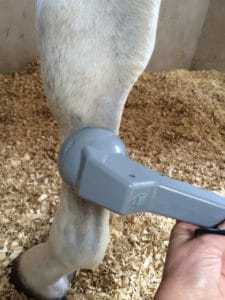
Carrie Schlachter, VMD, Dipl. ACVSMR, of Circle Oak Equine Sports Medicine, in Petaluma, California, published an article in the April 2016 edition of Veterinary Clinics of North America: Equine Practice reviewing electrophysical therapies for equine athletes. In it she states, “laser therapy is beneficial on wounds and tendon and ligament injuries, because it increases cellular proliferation and collagen synthesis, leading to more rapid healing of the damaged tissue.”
She says that while one study looking at horses with septic wounds found that laser therapy stimulated fibroblast formation and collagen synthesis, there is conflicting evidence of its effects on second-intent wound healing, in which the wound is left open to heal by itself.
Similarly, LLLT is used regularly as a treatment modality for tendon and ligament damage, but studies on its effect in horses are minimal. Schlachter cited LLLT studies done on rodents with tendonitis and rabbits with osteoarthritis that showed improved tendon properties and cartilage regeneration, respectively.
“Both of these studies provide promising evidence that similar effects may occur in our equine patients,” she says.
Pulsed Electromagnetic Field Therapy
The U.S. Food and Drug Administration approved pulsed electromagnetic field therapy (PEMF) for use in humans and animals in 1979, and veterinarians first used it primarily to treat fractures in racehorses. These devices produce pulses at a specific frequency and wave form with a goal of stimulating cellular action. The size of the magnet determines the waves’ depth of penetration and strength.
The reasons why veterinarians would use PEMF are similar to those for using LLLT: reducing pain and inflammation and hastening healing. But it works in conjunction with the earth’s magnetic fields, which affect positively and negatively charged microscopic molecules in cells called ions.
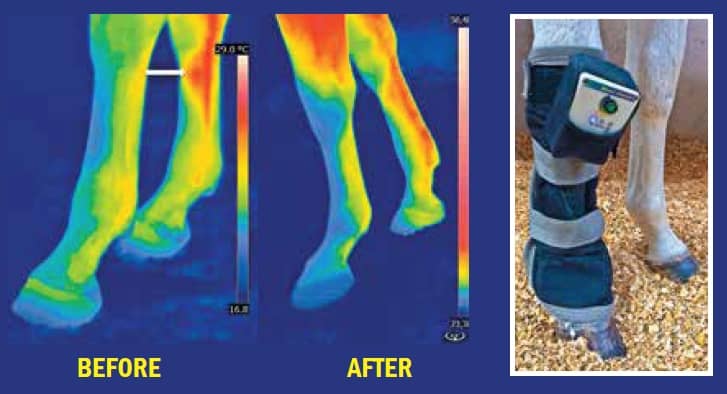
Results from other human studies have shown that PEMF causes an increase in the number of neuronal cells, which transmit nerve signals to and from the brain; improved circulation; and a reduction in edema. For this reason, some riders incorporate PEMF into their warm-up and cooldown routines to try to reduce their horses’ chances of injury or reinjury.
Other indications for use, based on Schlachter’s review, include bone healing, pain relief, and increased blood flow to tissues. “The strongest evidence for efficacy with PEMF lies with nonunion or slow-to-heal fractures,” she says.
Vibration Therapy
While therapies such as LLLT and PEMF are designed to treat a specific area, vibration therapy addresses the whole horse. During treatment sessions, horses stand on gently vibrating platforms that cause continuous involuntary muscle contractions believed to increase blood flow.
Improved blood flow to tissues can help reduce chronic inflammation by delivering oxygen and nutrients to fuel new tissue growth after an injury. Improved circulation also helps remove toxins, dead cells, and debris from the bloodstream.
Schlachter says owners and veterinarians use these units to help treat tendon and ligament injuries, maintain horses’ fitness, promote blood flow, and improve strength post-surgery.
Steve Adair, MS, DVM, Dipl. ACVS, ACVSMR, director of the Equine Performance Medicine and Rehabilitation Center at the University of Tennessee’s Veterinary Medical Center, is currently studying whole body vibration’s effects on bone density in horses using a TheraPlate.
“Whole body vibration (WBV) is a mechanical stimulus characterized by oscillatory motion delivered to the entire body from a platform,” says Adair. “WBV employs low-amplitude and low-frequency mechanical stimulation of the body for short durations to exercise musculoskeletal structures. In humans, WBV must be done daily for several weeks to months before musculoskeletal changes are noted. While there is some suggestion that WBV may aid in improving blood and lymphatic flow, the primary use is treating conditions of the musculoskeletal system. This would include osteoporosis, and osteopenia (low bone density).”
Adair adds that WBV might also strengthen muscle and improve joint stability and neuromuscular function.
Adair says he uses WBV on horses undergoing rehabilitation in an attempt to reduce bone loss from periods of prolonged inactivity. “It is important to realize that to obtain the benefits claimed in humans, a horse needs to be treated one to two times daily for several weeks,” he says. “A one-time treatment is of limited to no benefit.”
Heat Radiation Textiles
These textiles, which have heat reflective properties, are comprised of ceramic powder melted into the threads of a fabric. The fabric recruits the body’s own energy and warmth and reflects it back as a far-infrared wavelength, which can penetrate tissues. Scientists have documented that this long-wave infrared heat radiation can reduce pain and increase blood circulation.
In 2004 Swedish researchers performed a blind study of these products’ effect on 10 riding school horses with back problems. They split the horses into two groups. During the first three-week phase, one group wore normal blankets while the other group wore Back on Track back warmers under their blankets. Then a veterinarian and a professional rider, who did not know to which group each horse belonged, evaluated the horses. During the second three-week phase, the groups were switched and evaluated again at the end. Results showed that the back warmers helped improve eight out of 10 horses’ trots and seven out of 10 horses’ gallops.
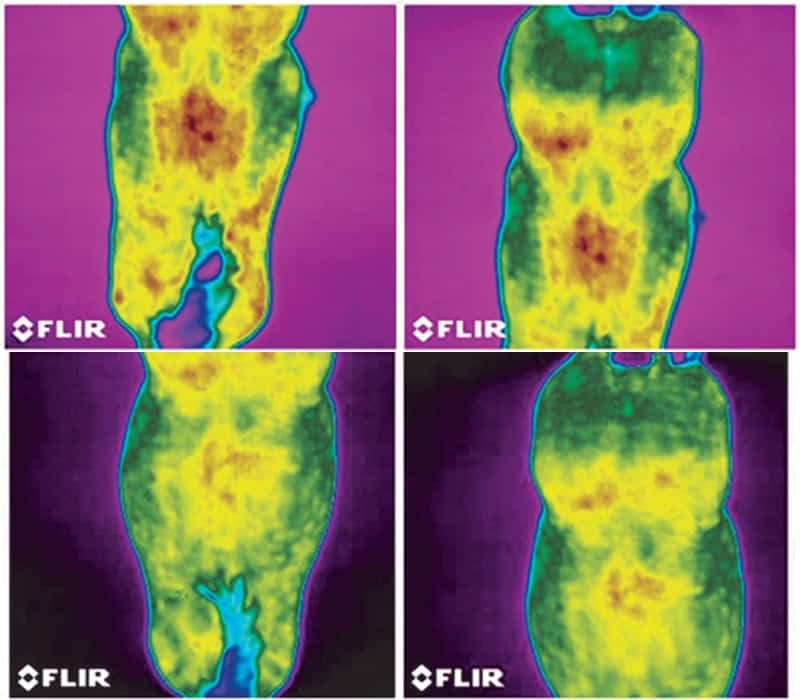
Werner has used the products on her own horses for soft tissue injuries and back pain. “I do recommend it to clients, because I think it has some effect, especially on soft tissue injuries in the lower limb,” she says.
Werner says these textiles can also be used as an ancillary therapy in addition to other treatments or to help body-sore competition horses that cannot receive analgesic drugs before or during a competition.
In another clinical study, Joanna Robson, DVM, CVSMT, CVA, CSFT, CIT, owner of Inspiritus Equine, in Napa, California, used thermography to detect inflammation in horses before and after using the Back on Track sheet. After seven weeks of wearing the sheet (starting with 30-minute sessions and working up to 12 hours), she noted a reduction in generalized inflammation and vertebral inflammation on thermographs.
“Anecdotally, all the horses definitely felt better in their backs to all the owners,” she says. “I can’t rule out a placebo effect, but even my own horse was much looser and fluid.”
Take-Home Message
Humans and horses alike have been benefitting from these and other high-tech therapies for years, but far fewer studies exist in horses than in human medicine. Often, it’s the horse’s physical response to the therapy that lets veterinarians know whether it is effective.
We don’t yet know how useful some of these modalities and tools truly are and whether they’re worth an owner’s investment. When making your decision, work with a veterinarian experienced in using these therapies.
Written by:
Sarah Evers Conrad
Related Articles
Stay on top of the most recent Horse Health news with















